It's Already the Third Day of 2025
The tennis calendar has never started as early as the 2025 season did this week.
My biggest beef with Taylor Swift—since you’ve probably been wondering—is over the opening line of the title track of her 2019 album, Lover.
“We could leave the Christmas lights up ‘til January,” Taylor sings. “This is our place; We make the rules.”
Ever since I first heard the song, I thought it was an utterly baffling opening example for Taylor to have used to show defiant independence. Who takes Christmas lights down before January? The official Christmas season famously runs for twelve days from December 25th through January 5th, leading up to Epiphany, which surely even the most aggressive HOA would have to abide. And in my own non-regulated abodes, Christmas lights and various other decorations routinely linger for weeks beyond that, a joyful bit of procrastination that keeps the merriment aglow a little longer.
The lyric especially annoys me because “February”—a genuinely lightly transgressive month for Christmas decor—was right there for Taylor with the same number of syllables. “Christmas lights up ‘til February” is such an easy fix. We should all expect much better calendar awareness from someone who measures her own career in “eras.”
I wanted to establish this lingering Christmas ethos of mine just to iterate that Christmas felt nowhere near over a couple nights ago, on the evening of December 26th. But as I sat on the couch next to bags of torn-up wrapping paper that still hadn’t made it out to the recycling bin yet, Pablo Carreño Busta and Alexander Shevchenko walked into RAC Arena in Perth and onto my TV screen for the opening match of the 2025 United Cup, officially marking the start of the 2025 tennis season.
It was the morning of December 27th in Australia, but even there it was still right in the heart of the smack of the dab of Christmas, surely. And yet here was tennis, unapologetically back and raring to go anew.
Starts of Christmas Past
I was right to feel jarred: as I dug through tour calendars of yesteryear, I found that a December 27th start was indeed unprecedentedly early in this era of tennis. After being held in December from 1977 through 1985, the Australian Open moved to January in 1987, giving the season the structure we have known ever since. But until this year, never before had an official season-opening ATP or WTA tournament started so far into December—or, put a more colloquial way, so close to Christmas.
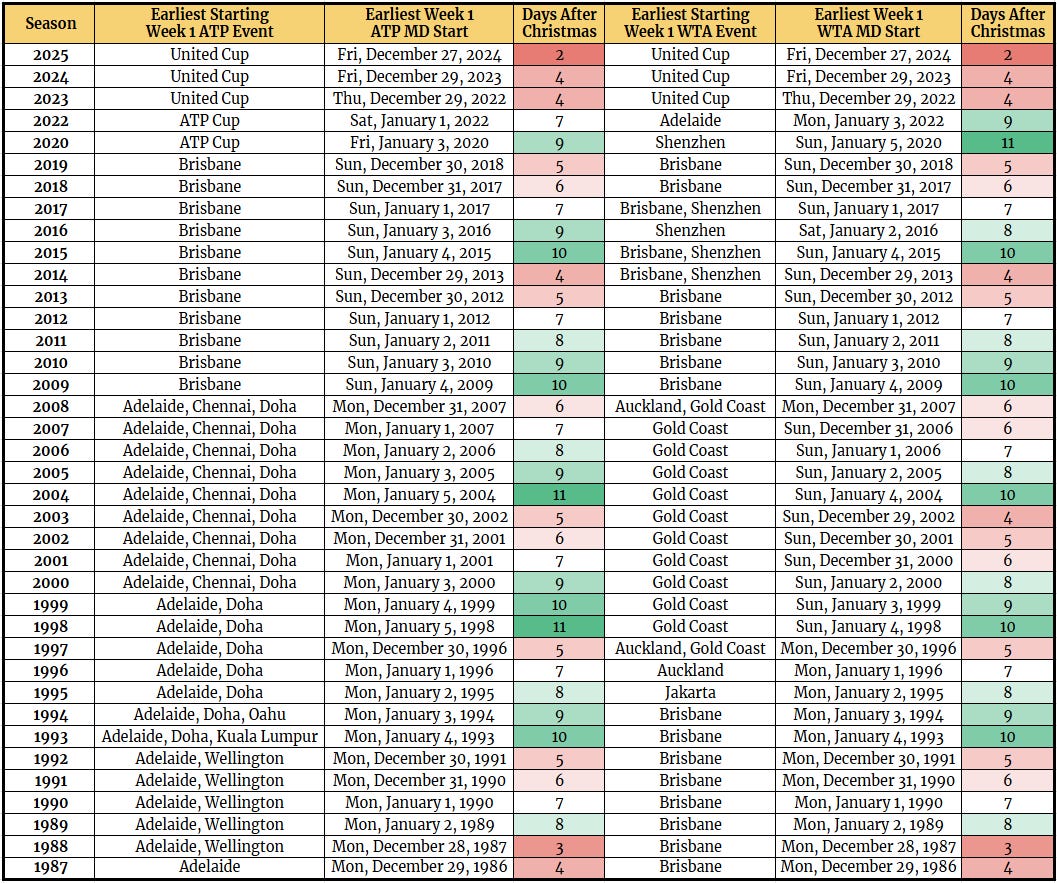
You can see on that chart that there are natural undulations regarding which dates on the calendar fall on which day of the week as years progress, but also that Week 1 start dates shifted a couple days earlier in recent years.
When ATP-WTA Brisbane launched in 2009, it began main draw play on a Sunday instead of the traditional Monday. Then when the short-lived ATP Cup was launched in 2020, it took two steps further into a Friday start, even dabbling with a Thursday start in 2022.
These events are not only creeping earlier, they’re getting more tempting for players. In the early years of the Australian Open’s stint in January, the events that were held in the opening week were lower-tier events that mostly attracted pretty weak competition; most of the top players waited a week until beginning their seasons in Sydney in the second week of the season.
But as playing the week before a major fell out of favor (more on that trend in a later post), the weeks that are two weeks out from the start of a major—think Rome, Halle/Queen’s Club, Cincinnati—became+ the prime week for top contenders to do their primary major prep.
For this exercise, I should mention, I’m only counting official ATP and WTA tournaments that offer ranking points. That doesn’t include the Hopman Cup, a beloved exhibition event held in Perth in the first week of the season for 31 years, which used to start a day or two before the tour events in most of its years; when it first began, it was right up against Christmas.
Increasing the Pull
But exhibition events—including the ATP NextGen event that was held in Jeddah in mid-December—don’t offer ranking points and thus don’t put any player at a competitive disadvantage for skipping them. These newly-loaded Week 1 events come with incentives that make them feel more compulsory to players.
When the ATP-WTA Brisbane event began in 2009, it marked the first time that any event above what’s now called the 250-level was held in the first week of the season: the WTA’s half of Brisbane was at the 500-level (then known as “Premier.”) The United Cup now operates roughly at the 500-level, too, and offers ranking points, prize money, and lucrative appearance fees to entice the biggest stars to head Down Under earlier than they otherwise would.
You may be thinking that “Days After Christmas” is a goofy metric, and you might be right, so here’s also the changes in the length of the offseason—measured from Tour Finals to Week 1—which has also crept shorter in recent years.
The brevity of the tennis offseason, though, is an important but well-covered story; the Christmas creep discussed above is a more recent phenomenon. And I think it matters: pulling players away from home during the holidays—while not all players are of Judeo-Christian origins, a majority on tour are—is disruptive to their lives and mental health. In order to arrive in distant Australia in time for the United Cup, more than 100 players—and various other personnel who work on the tours in various other capacities from coaching to physiotherapy to media—missed the holidays at home this year because of this early start. I think for some of these people that could ultimately have a meaningful—if not measurable—effect on their emotional wherewithal for months ahead.
In some ways tennis is a straggler in this phenomenon: the NBA has been playing games on Christmas Day for years, and the weekend-centric NFL joined in this year despite the holiday falling on a Wednesday, adding the glittery power of Beyoncé as high-grade tinsel.
Tennis hasn’t—and shouldn’t—ever go that far. There was scant attendance at that match in Perth between Carreño Busta and Shevchenko; folks in Perth were probably home still in their post-Christmas afterglows as well. There’s just not a big reward for putting fairly obscure players on at unseasonable times.
Mostly because of natural calendar fluctuations—and a bit by the new Sunday start—the Australian Open starts and ends earlier this year too, running from Sunday, January 12th (its earliest start date since 1988) until Sunday, January 26th.
That means all the players, even the champions, can be home in plenty of time to take down their Christmas lights by the end of January.
Thanks for reading! Merry Christmas, Happy Hanukkah, and Happy (Early) New Year!
-Ben





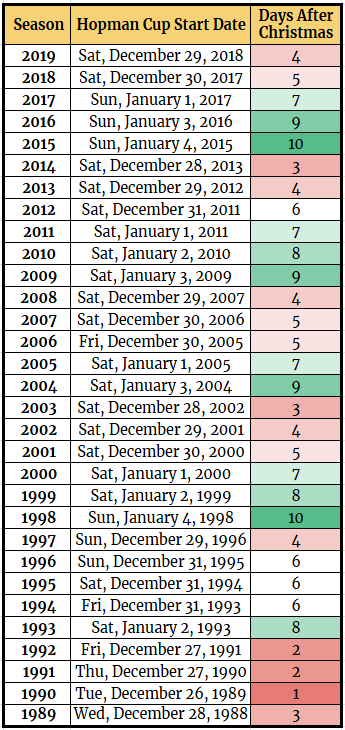
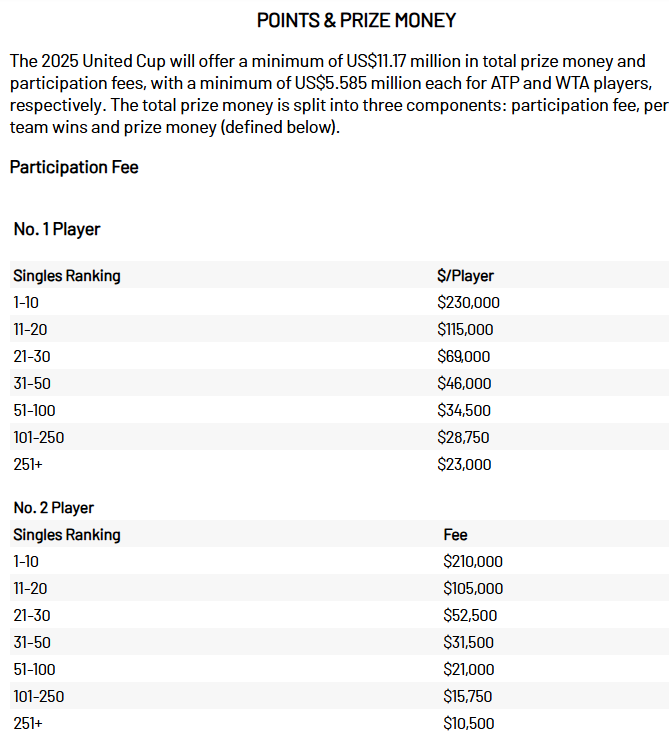
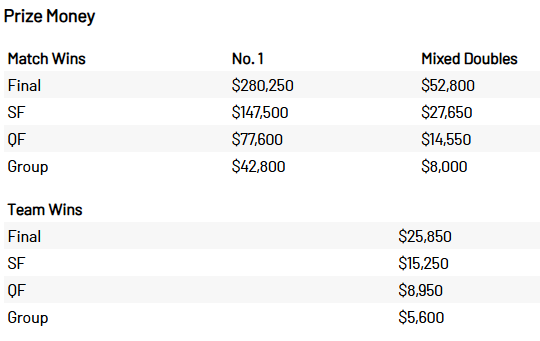
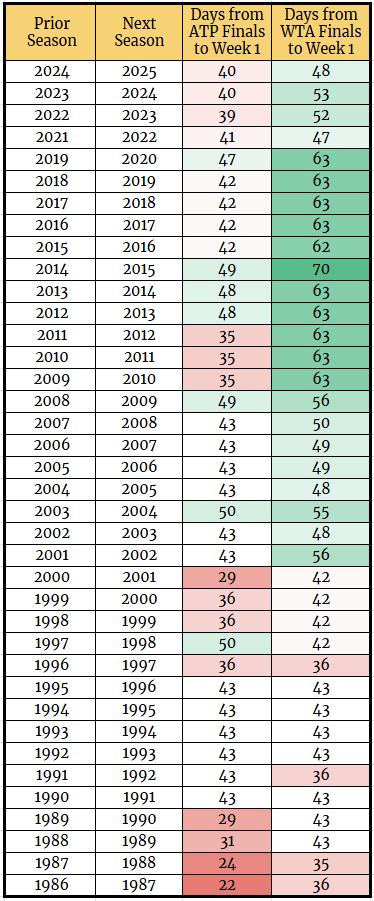
You're a fine tennis writer, Ben, but don't go into songwriting. "February" is an absolute mouthful of a word to sing - does one pronounce the first R, in which case it sounds like you're gargling marbles? Or do you sing it as "Febuary", in which case everyone will look around and say "that's not how it's pronounced!" I agree that the existing lyric is a bit daft, but if Taylor were really going for the extreme, she could say "We can leave the Christmas lights up until March." Doddle to sing. Also makes one sound like an absolute sloven. So, January it is.
In fairness, the Shevchenko - Carreno Busta match had a Thursday morning at 10am start time that is generally off-putting for spectators at any tournament, regardless of Christmas.
I'm not sure about the mental health toll of spending Christmas away from family for European players or staff members. Anyone working in tennis already spends weeks and weeks on the road away from their loved ones, it's just the cost of doing (this) business, I don't think they take particular notice of this specific holiday they cannot celebrate at home. But everyone is different, so someone maybe is resenting it. But that's show business.